5 Best PDF Report Tools for Construction Teams
Managing construction documentation is easier with the right PDF tools. Whether it's progress reports, safety inspections, or compliance paperwork, these tools simplify workflows, reduce errors, and improve collaboration. Here's a quick look at the best options:
- Project Lens: Tailored for contractors, combines PDF reporting with project management. Includes unlimited storage and mobile apps for $25/month per user.
- Bluebeam Revu: Ideal for technical tasks with advanced markup and measurement tools. Starts at $260/year per user.
- PlanGrid: Mobile-friendly for on-site reporting with offline access. Priced at $39/month per user.
- ActiveDraft: Simple PDF editing with pre-designed templates. Costs $15/month per user.
- Foxit Reader: A budget-friendly option with a free basic version and paid upgrades for advanced features.
Quick Comparison
| Tool | Starting Price | Mobile Apps | Offline Access | Key Features |
|---|---|---|---|---|
| Project Lens | $25/month/user | iOS & Android | Yes | PDF reporting + project management, unlimited storage |
| Bluebeam Revu | $260/year/user | iOS & Android | Yes | Advanced markups, 2D/3D tools, automation |
| PlanGrid | $39/month/user | iOS & Android | Yes | On-site reporting, version control |
| ActiveDraft | $15/month/user | Web-based | Limited | Pre-designed templates, easy editing |
| Foxit Reader | Free (basic) | iOS & Android | Yes | Basic PDF tools, shared reviews |
Each tool caters to different needs. Project Lens is great for contractors managing multiple sites, while Bluebeam Revu serves technical teams. For fieldwork, PlanGrid excels in mobility, while ActiveDraft and Foxit Reader are cost-effective for simpler tasks. Test these tools to find the best fit for your team.
Mastering Area Quantity Takeoffs in Bluebeam Revu: A Step-by-Step Guide
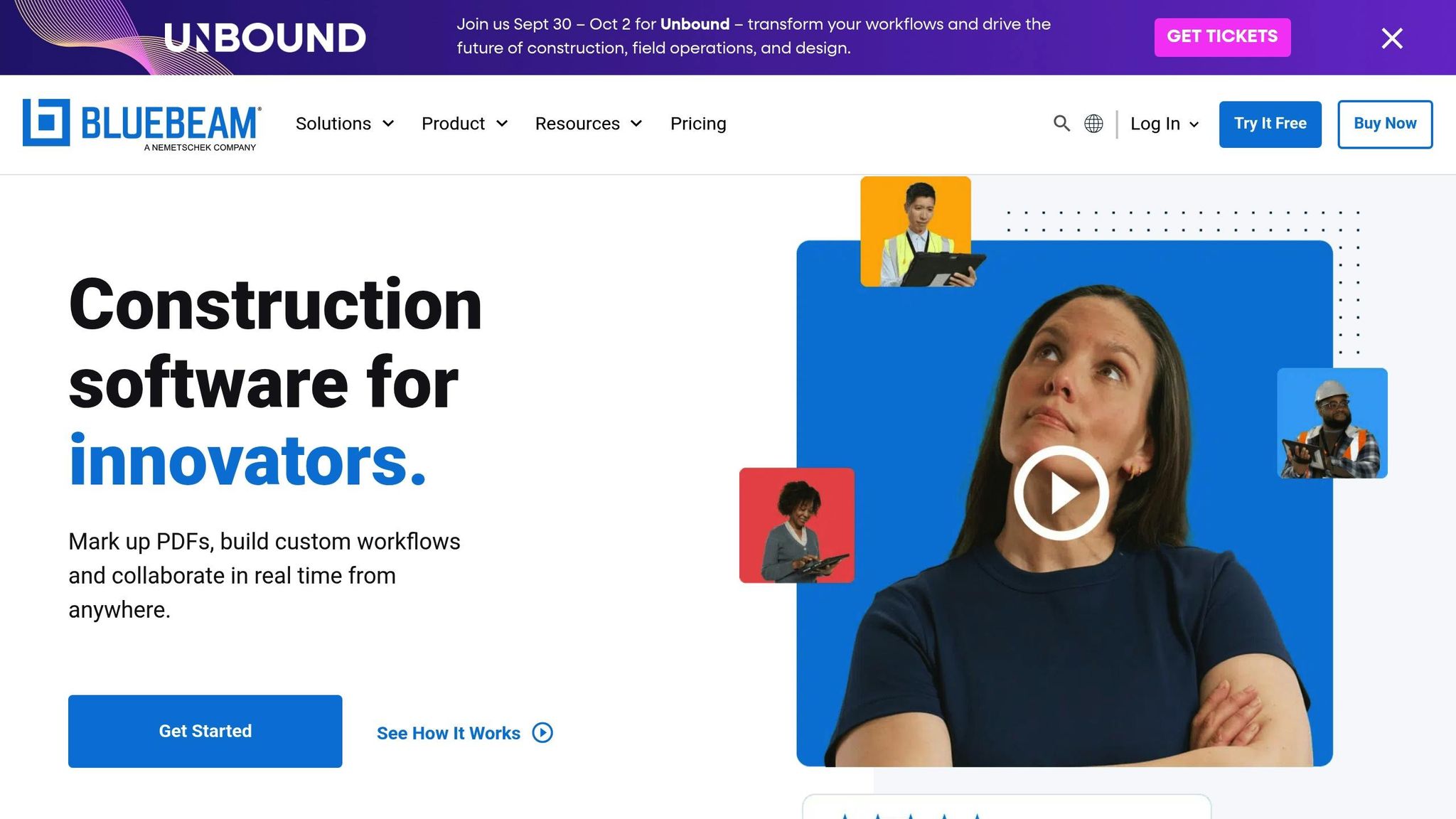
1. Project Lens
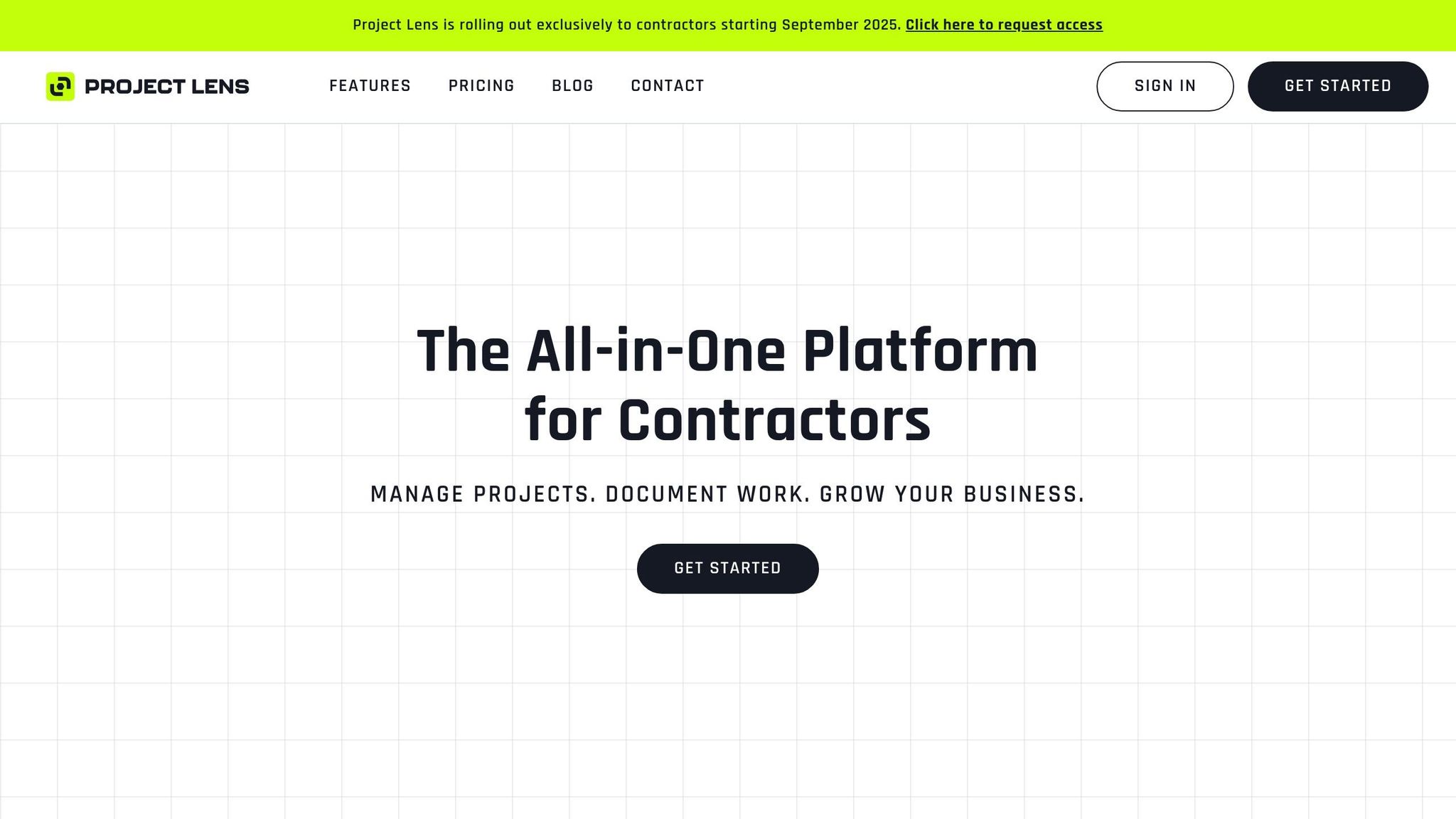
Project Lens is designed specifically for contractors who need reliable PDF reporting and comprehensive project management tools. Tailored for the construction industry, it tackles the challenges of managing documentation across multiple job sites while maintaining the professional standards clients expect. Let’s take a closer look at how Project Lens simplifies documentation and enhances project workflows.
PDF Generation & Markup
One standout feature of Project Lens is its ability to create polished PDF reports tailored to any project. It automatically compiles data, photos, and documents into consistent, professional formats. Whether it's daily progress updates, safety inspections, change orders, or compliance documents, construction teams can generate reports in just a few clicks.
Field teams can capture unlimited photos and videos (up to 5GB each), which are automatically sorted by location and date. These media files seamlessly integrate into PDF reports, complete with geocoding and map visualizations, offering precise details about where and when work took place.
Collaboration Features
Project Lens goes beyond just creating reports - it boosts teamwork with powerful collaboration tools. Features like instant notifications, activity feeds, and real-time updates ensure that everyone stays informed about project developments. When reports need reviewing or approval, the platform keeps workflows smooth and efficient.
The built-in task management tools allow project managers to assign and monitor documentation tasks across multiple projects. Team members can use comments and @mentions to discuss reports or media directly, keeping conversations organized and relevant.
"Our clients love the professional documentation and real-time updates", says Sarah Chen, Project Manager at Elite Construction.
Collaboration doesn’t stop with document sharing. Multiple users can work together on report creation, with version control and audit trails ensuring compliance and accuracy throughout the process.
Mobile Accessibility
With native apps for iOS and Android, Project Lens ensures field teams stay connected, even offline. The apps allow workers to capture updates, take photos, and generate reports that automatically sync when back online. Push notifications ensure no update goes unnoticed.
This mobile-first approach also empowers project managers to review and approve reports from anywhere, minimizing delays when key personnel are unavailable. Field workers can quickly update task progress through the app, giving managers real-time insights for accurate reporting.
"Finally, a complete platform built for contractors. The task management and unlimited storage are game changers", says David Thompson, General Contractor at Thompson Builders.
Pricing
The Pro Plan is priced at $25 per user per month when billed annually. It includes all collaboration tools, unlimited media storage, and PDF generation, with no setup fees or minimum user requirements.
For larger teams, the Enterprise Plan offers custom pricing for groups of 50 or more users, with volume discounts available. This plan includes everything in the Pro Plan, plus advanced security features, Single Sign-On (SSO), dedicated account management, and priority support.
For those needing flexibility, monthly billing is also available at a 20% premium over annual rates, making it a great option for seasonal contractors or teams working on short-term projects.
2. Bluebeam Revu
Bluebeam Revu stands out as a go-to PDF solution for the construction industry, earning a solid 4.7/5 rating from 987 reviews. While Project Lens leans toward specialized project management, Bluebeam Revu excels with its advanced markup tools and measurement capabilities, making it indispensable for technical tasks. Here’s a closer look at what it offers.
PDF Generation & Markup
Bluebeam Revu simplifies the creation and editing of technical PDFs, offering specialized markup tools tailored for 2D and 3D drawings. Its measurement tools vary by plan, covering everything from basic dimensions to more detailed metrics like perimeter, angles, counts, and volume. The Dynamic Fill feature takes it a step further, calculating areas and volumes automatically to speed up project estimates.
"So many functions that are pertinent to the construction industry that I can use on a daily basis from viewing files to doing quick measurements to editing files to combining or converting to and from PDF files", shares Kelsey, a verified construction industry reviewer.
Automation is another strong suit. Features like Batch Link® for hyperlink automation and Batch Slip Sheet for managing document revisions streamline large-scale document processing. Additionally, the Quantity Link integration with Microsoft Excel ensures seamless data transfer between measurements and spreadsheets, making calculations more efficient.
Collaboration Features
Bluebeam Revu’s collaboration tools are built for teams that need to work together in real time. With Studio Sessions, multiple users can simultaneously mark up the same PDF, and detailed activity logs help maintain version control. This transparency ensures everyone stays on the same page.
Eric, an architecture and planning professional, notes, "Love using sessions and seeing mark-ups in real time along with a log of who was working and modifying certain things."
Collaboration isn’t limited to the desktop app. Bluebeam Cloud extends access to web browsers and mobile devices, allowing team members to manage Studio collaborations from virtually anywhere. The detailed audit trails provided by the platform add another layer of accountability and make project tracking smoother.
Mobile Accessibility
For teams in the field, Bluebeam Cloud’s mobile apps bring the power of PDF markup to job sites. The mobile version retains the core functionality of the desktop app, ensuring consistency across devices. Field teams can capture site conditions, add markups, and participate in collaborative sessions without needing a workstation.
Taras mentions, "The cloud-hosted design means lost connection turns my dot red, and closing the program offline can result in lost changes."
This mobile accessibility ensures that field personnel stay connected with office workflows, keeping projects moving efficiently.
Pricing
Bluebeam has moved to a subscription-based model, offering three tiers tailored to different team needs:
| Plan | Annual Price | Key Features | Best For |
|---|---|---|---|
| Basics | $260 per user | PDF creation, basic markups, and simple measurements | Document management and straightforward tasks |
| Core | $330 per user | Basics plus advanced 2D/3D tools, CAD plug-ins, and detailed measurements | Professional-grade markups for mid-sized projects |
| Complete | $440 per user | Core plus Dynamic Fill, Excel integration, and workflow automation tools | Complex projects requiring advanced capabilities |
All plans include technical support, unlimited secure storage, and access to Bluebeam University training courses. Subscriptions allow installation on up to three devices, with one active at a time. For larger organizations with specific needs, custom solutions are available through Bluebeam’s sales team.
While the subscription model has received mixed feedback, many users find the investment worthwhile. As Kelsey, a verified reviewer, puts it:
"Probably my biggest con for Bluebeam is the cost of the software. It is a little pricey, little higher than competitors. But well worth it if you use this program on a daily basis."
3. PlanGrid
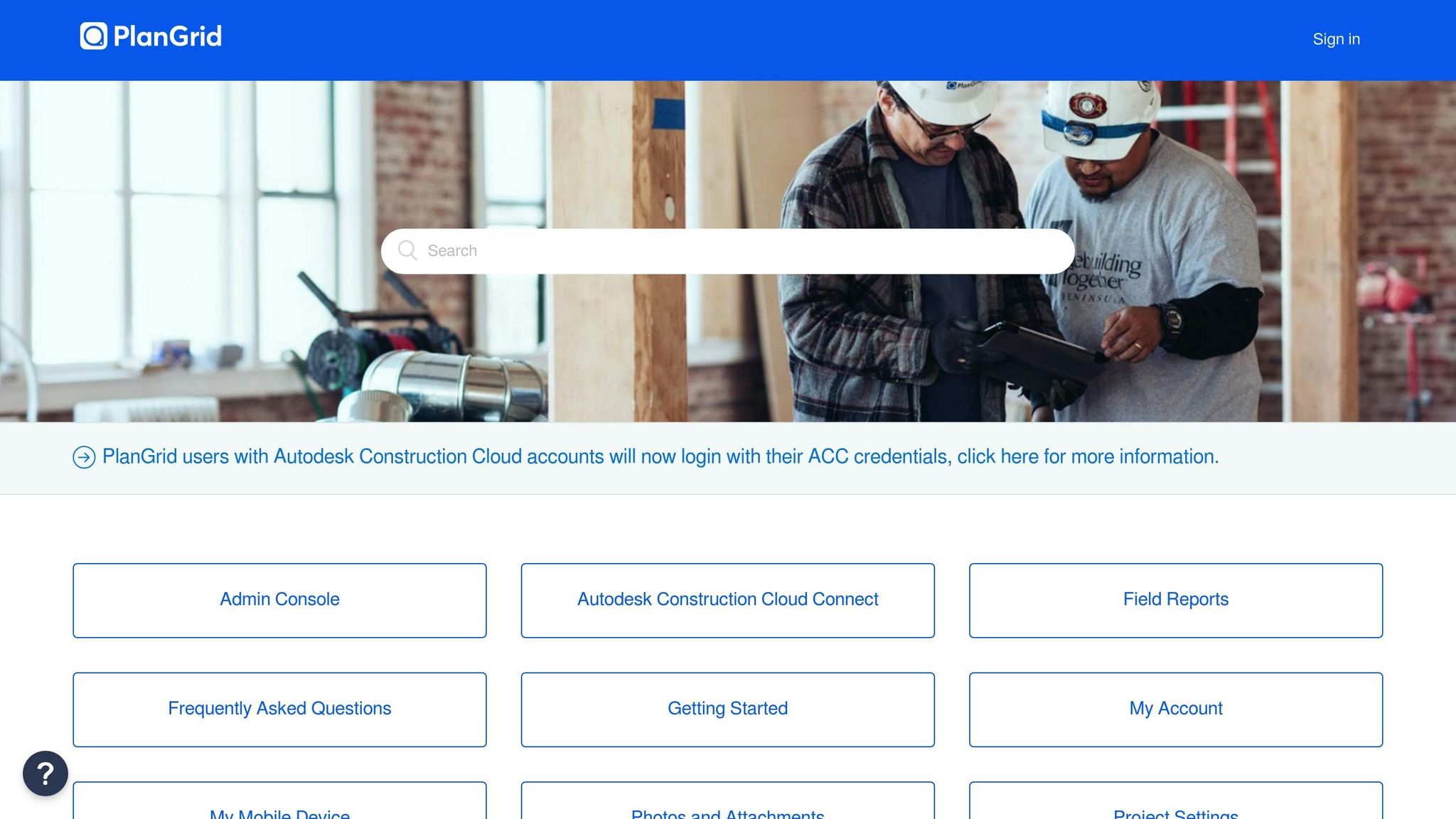
PlanGrid keeps the focus on simplifying on-site documentation and improving real-time collaboration. With its mobile-friendly PDF reporting, it ensures that site documentation is consistent and easy to manage.
PDF Generation
The Field Reports feature is designed to make creating, sharing, and archiving reports straightforward. It allows teams to generate standardized PDF reports directly on-site, ensuring consistency and accessibility.
But it's not just about generating reports - PlanGrid also provides tools that make collaboration among team members smooth and efficient.
Collaboration Features
PlanGrid enhances team communication with flexible collaboration modes tailored for on-site reporting. Users can select from three different approaches:
- Single Contributor: A single team member completes and submits the report independently.
- Multiple Contributors in Sequence: Team members add their inputs one after another through a structured handoff process.
- Multiple Contributors in Parallel: Several team members work on the same report simultaneously, which is particularly useful for complex tasks like inspections.
To ensure quality and accountability, PlanGrid incorporates a reviewer system. Designated reviewers can access draft reports, provide feedback, and make necessary revisions, promoting transparency throughout the process.
"Reassigning field reports within PlanGrid allows even more robust collaboration in the planning, verification and completion of activities between various project functions!" - Simon Bowen, Corporate Manager - Quality & Systems, CPB Contractors
sbb-itb-56a818c
4. ActiveDraft
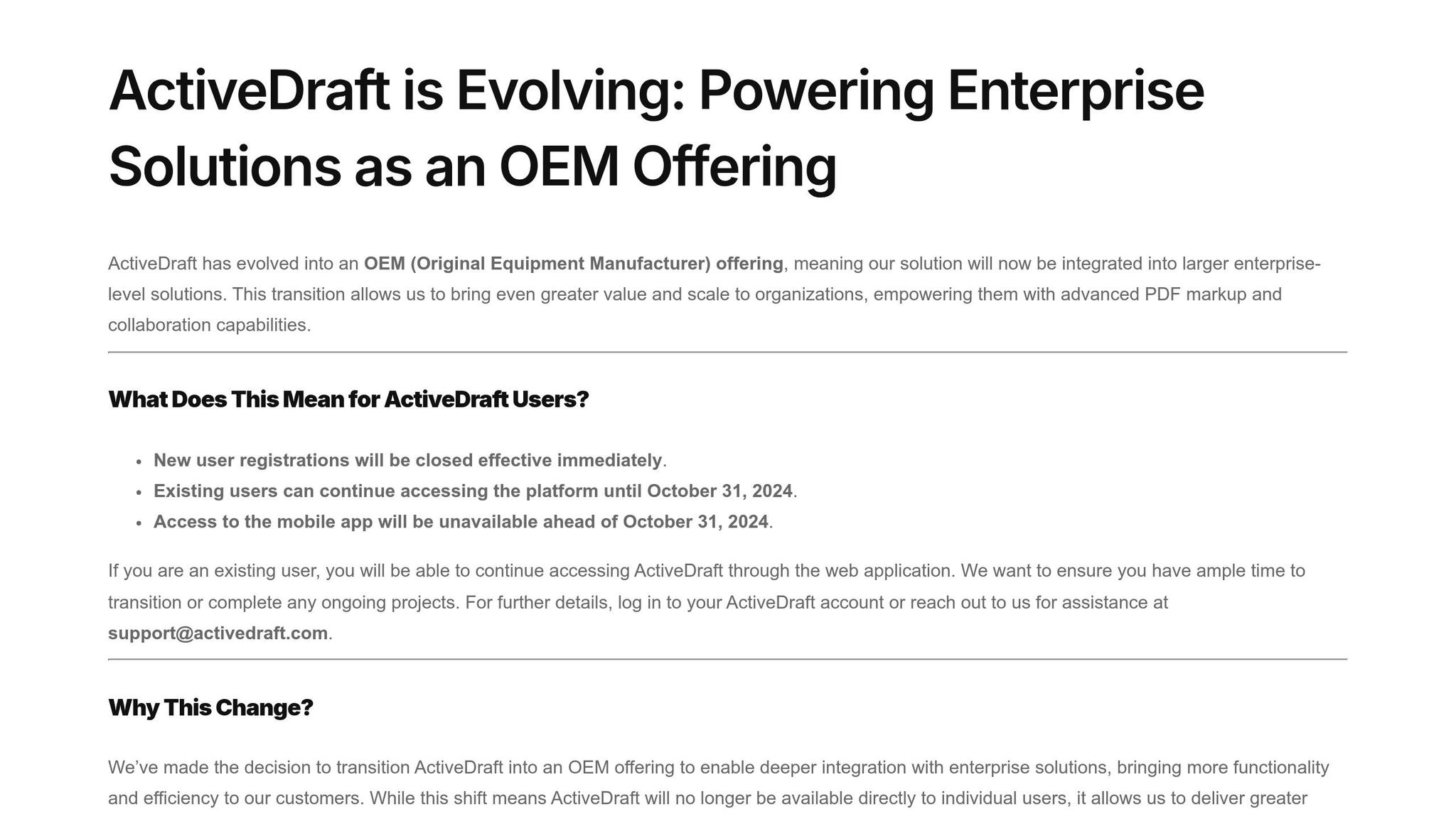
ActiveDraft is a straightforward tool designed to simplify PDF reporting for construction professionals. It focuses on the essential features needed for everyday documentation tasks, making it an efficient choice for managing construction-related reports.
PDF Creation and Markup
With ActiveDraft, creating and marking up PDFs is a breeze. It offers pre-designed templates tailored for construction documents, allowing users to customize branding and add annotations like text boxes, arrows, and highlights. This makes it quick and easy to generate polished, professional reports.
Mobile-Friendly Features
ActiveDraft fits seamlessly into mobile workflows, even in challenging environments. The mobile app works offline, letting you create and edit reports on sites with poor connectivity. Once you're back online, the app syncs your changes without losing any formatting or annotations. Its interface is also optimized for tablets, giving field supervisors a convenient way to handle detailed markups during site visits.
Pricing
ActiveDraft operates on a subscription model with tiered plans to suit different team sizes. A free trial is also available for those who want to test the platform before committing.
5. Foxit Reader
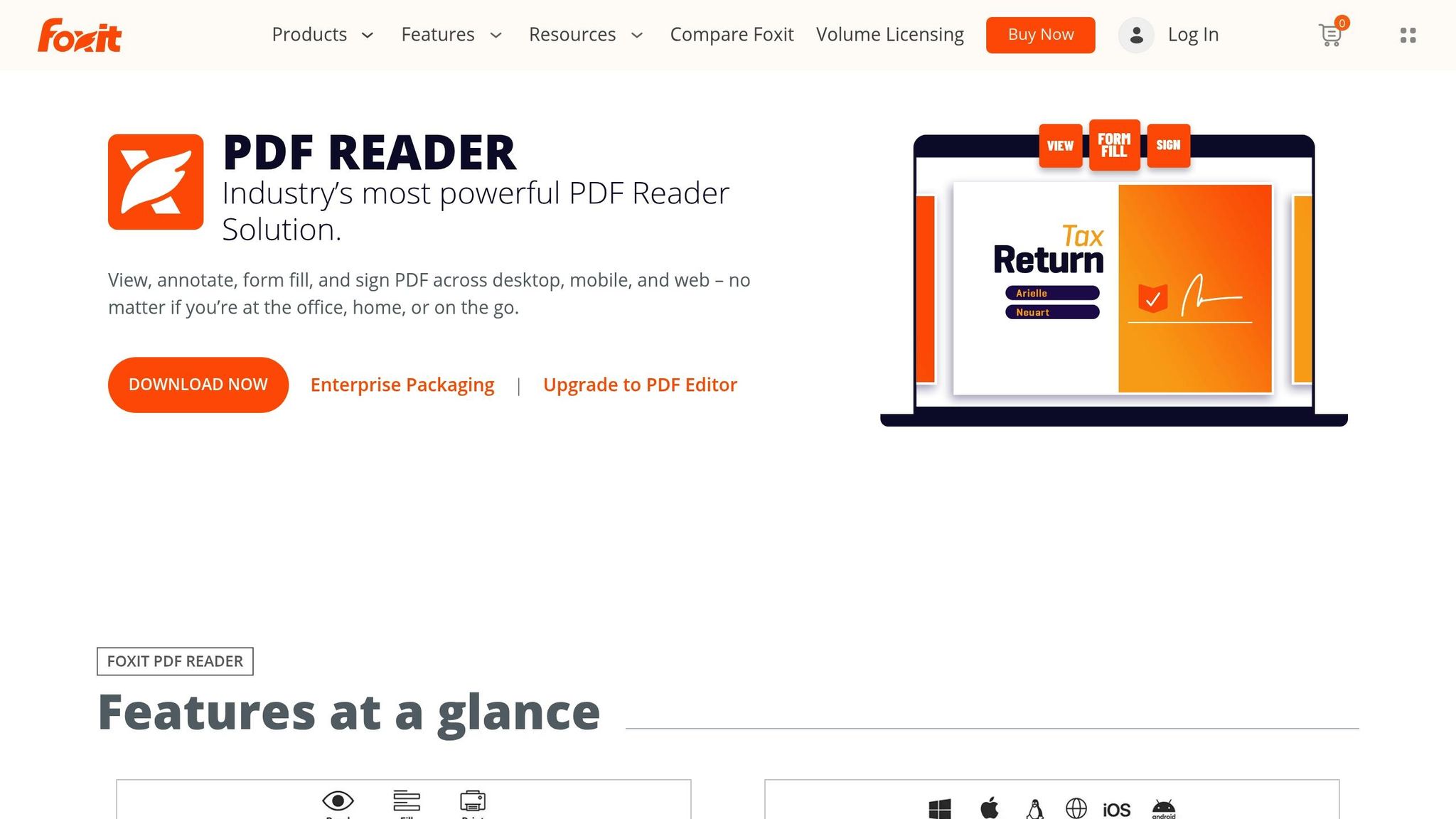
Foxit Reader is a handy PDF tool designed to simplify daily construction documentation. It combines robust editing capabilities with straightforward features, making it suitable for both tech-savvy project managers and field workers who need practical, easy-to-use tools.
PDF Generation & Markup
Foxit Reader allows you to create professional PDFs and provides a range of markup tools like callout boxes, measurement features, and custom stamps. Teams can annotate blueprints with highlights, sticky notes, and drawing tools, ensuring that technical details remain clear - even on large, complex drawings.
These markup tools are particularly useful for collaborative reviews. Team members can highlight specific areas of blueprints, add notes for clarification, or draw directly on floor plans to provide detailed feedback.
Collaboration Features
Foxit Reader's shared review function lets multiple stakeholders comment on documents at the same time. This creates a unified record of feedback, helping to streamline decision-making and reduce miscommunication.
Pricing
Foxit Reader operates on a freemium model, making it a flexible option for small teams. The basic version, which includes essential PDF viewing and annotation tools, is free. For teams that need advanced collaboration and markup features, paid plans are available at competitive rates, scalable based on team size and specific needs.
This pricing structure allows teams to start using the tool for free and upgrade as their documentation requirements grow. It’s an economical choice for construction teams looking for a reliable PDF solution.
Tool Comparison
When comparing PDF report tools, it’s clear that each option has its strengths and trade-offs, depending on your project needs, team size, and budget. The table below summarizes the key differences to help you quickly identify the best fit.
Project Lens is a robust choice for teams needing PDF reporting integrated with project management tools. At $25/month per user, it includes unlimited media storage and full project management capabilities. However, for teams with simpler needs, it might feel like overkill.
Bluebeam Revu stands out for its advanced markup and collaboration tools, especially for technical drawings. Architects and engineers will appreciate its precision features, but field users may find the learning curve steep.
PlanGrid is designed with mobility in mind, offering version control and offline access to address on-site challenges. However, its PDF editing tools are less comprehensive compared to desktop-oriented solutions.
ActiveDraft provides effective collaboration at a competitive $15/month per user. It’s a strong option for teams seeking reliable PDF editing without the added complexity of industry-specific tools. While the interface is user-friendly, it lacks some specialized construction features.
Foxit Reader is an affordable choice with its freemium model, allowing users to start free and upgrade when needed. It covers basic PDF tools but doesn’t include advanced features for construction or project management.
| Feature | Project Lens | Bluebeam Revu | PlanGrid | ActiveDraft | Foxit Reader |
|---|---|---|---|---|---|
| Starting Price | $25/month/user | $240/year/user | $39/month/user | $15/month/user | Free (basic) |
| Mobile Apps | iOS & Android | iOS & Android | iOS & Android | Web-based | iOS & Android |
| Offline Access | Yes | Yes | Yes | Limited | Yes |
| Unlimited Storage | Yes | No | Limited | No | No |
| PM Integration | Full CRM & Pipeline | Basic | Yes | Limited | No |
| Real-time Collaboration | Yes | Yes | Yes | Yes | Yes |
| Custom Reporting | Professional PDFs | Advanced | Standard | Basic | Basic |
| Industry-specific Tools | Construction-focused | AEC-focused | Construction-focused | General | General |
| Learning Curve | Moderate | Steep | Easy | Easy | Easy |
Choosing the right tool depends on your team’s priorities, technical expertise, and work environment. If you need a solution that combines project management with PDF capabilities, Project Lens is a strong contender. For teams focused on technical drawing markups, Bluebeam Revu is a better fit. Field-based teams will benefit from PlanGrid's mobile-first design, while Foxit Reader is ideal for budget-conscious users. Lastly, ActiveDraft is a great pick for teams wanting simple, effective PDF editing without added complexity.
Most tools offer trial periods, so take advantage of this to test them with your own project files. This hands-on approach will help ensure you choose the best tool for your team’s specific needs.
Conclusion
Finding the right PDF report tool depends on your workflow, team size, and integration needs. Each tool has its own strengths, tailored to different aspects of construction work. Here's a quick rundown to help you decide:
- Project Lens: A comprehensive solution combining PDF reporting with full project management for $25/month per user. Ideal for general contractors, specialty trades, and project managers looking to streamline both documentation and project workflows.
- Bluebeam Revu: Perfect for teams needing advanced markup options for technical tasks.
- PlanGrid: Designed for field teams, with a mobile-first approach and offline capabilities.
- ActiveDraft and Foxit Reader: Budget-friendly options, with free tiers offering basic functionality for teams aiming to save on costs.
When choosing, consider factors like mobility, integration with existing tools, budget constraints, and your team’s specific expertise. For those juggling multiple projects, Project Lens might be the go-to option due to its integrated features. Meanwhile, specialized teams may prefer tools like Bluebeam Revu or PlanGrid for their targeted capabilities.
Streamlined reporting not only improves project oversight but also ensures your team delivers the professional results clients expect. Take advantage of free trials to test these tools with your own project files and see which one enhances efficiency without adding unnecessary complexity.
FAQs
How does Project Lens improve collaboration for construction teams using PDF reports?
Project Lens brings construction teams together by merging real-time communication, project management, and document sharing into one easy-to-use platform. Team members can quickly share updates, give feedback, and resolve issues, cutting down on delays and confusion.
By combining multiple tools in one place, Project Lens helps teams make decisions faster and keeps workflows running smoothly. It ensures everyone is aligned, making it a powerful tool for improving collaboration and productivity on construction projects.
What makes Bluebeam Revu a great tool for technical tasks in construction?
Bluebeam Revu shines with its tailored tools crafted specifically for construction professionals. It provides advanced measurement features that allow for precise calculations, a dynamic fill function to streamline complex measurements, and robust document management tools to help organize and collaborate on construction drawings and reports.
These features enhance project precision, accelerate workflows, and simplify the process of reviewing and sharing essential documentation. Designed to meet the rigorous demands of construction projects, Bluebeam Revu is a go-to solution for handling technical tasks in the industry.
How does PlanGrid's mobile-friendly design help construction teams work more efficiently on-site?
PlanGrid is designed with mobility in mind, giving construction teams the ability to access project plans, drawings, and BIM models right from their smartphones or tablets. Whether you're on-site or moving between locations, you can easily view, update, and annotate documents in real-time.
This instant access and streamlined communication mean fewer delays, smoother teamwork, and a noticeable boost in productivity. Team members can stay in sync and handle tasks effectively from anywhere on the job site.
